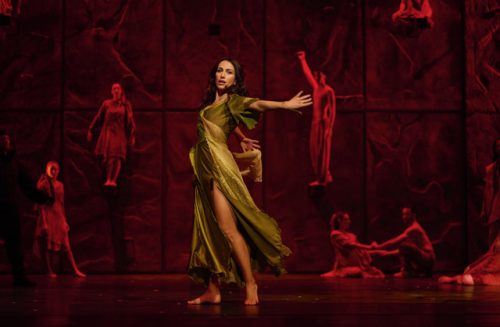 United States Luc Plamondon and Richard Cocciante, Notre Dame de Paris: David H. Koch Theater, New York, 12.7.2023. (RP)
United States Luc Plamondon and Richard Cocciante, Notre Dame de Paris: David H. Koch Theater, New York, 12.7.2023. (RP)

There have been some tectonic shifts in the pop culture landscape in recent months. Phantom of the Opera closed on Broadway in April after thirty-five years and 13,981 performances. And after more than fifty years on the road, Elton John just performed the last concert of his ‘Farewell Yellow Brick Road’ in Stockholm. However, the blockbuster Notre Dame de Paris is still going strong some twenty-five years after its 1998 premiere in Paris.
According to the Guinness Book of Records, Notre-Dame de Paris had the most successful first year of any musical ever. It has been a global hit ever since, performed in multiple languages everywhere from Las Vegas to Singapore in various versions. There have been multiple recordings and many instrumental arrangements of the score.
Individual songs, including ‘Vivre’, ‘Belle’ and ‘Le temps des cathédrales’, have been released as singles to great success in French-speaking countries. Celine Dion starred in an English-language studio recording of the musical and had a hit with ‘Live (for the one I love)’, an English version of ‘Vivre’, the musical’s showstopper song.
Writer Luc Plamondon and composer Richard Cocciante were inspired to create Notre-Dame de Paris from Victor Hugo’s epic 1831 novel of the same name. The book is a classic of Romantic French literature and has been adapted many times for film, stage and television, including the full Disney treatment as an animated film in 1996. It also served to establish the Parisian cathedral as a French cultural landmark and provided impetus to the entire French historical preservation movement.

Set in Paris in the fifteenth century, the story centers upon the beautiful Esmeralda (an enchanting Elhaida Dani), a Romani whose sexual allures captivate four men: the soldier Phoebus (Jérémy Amelin), poet Gringoire (Gian Marco Schiaretti), Archdeacon Frollo (Daniel Lavoie) and Quasimodo (Angelo del Vecchio), the hunchbacked bell ringer at the cathedral. Given sanctuary by Frollo as a baby, Quasimodo is devoted to both the cathedral and the archbishop, but he has the purest of loves for Esmeralda. The cleric’s obsession over Esmeralda eventually leads to both his and her deaths.
As with Les Misérables, Hugo incorporates universal themes – marginalization of the disenfranchised, love and redemption, justice versus injustice – into Notre-Dame de Paris. Plamondon and Cocciante did not shy away from addressing them in their musical, especially the plight of the marginalized in society. Two scenes with undocumented persons seeking asylum resonate as strongly as they did in either Hugo’s era or the late 1990s when the musical premiered. And perhaps even more so today in light of the current plight of refugees everywhere, as well as the riots and protests that rocked France last month.
The principals of the international cast are veterans of prior productions and identify completely with their roles. Performed in French with English translations projected on either side of the stage, the production is short on spectacle while abounding in melodies sung to over-amplified accompaniments that impose an ear- and mind-numbing homogeneity on the performance, although Cocciante definitely has a knack for melody.
The first act comes alive through the choreography, especially the ripped male dance troupe that bounds across the stage in all manner of acrobatic feats. At the intermission, you find yourself awed by the dancer’s energy and agility and humming the ear worm that coursed through almost every scene.
Costumed in sackcloth, the dancers make far less of an impact in Act II. There is, however, more dramatic urgency to the action and greater variety in the music numbers. Dani did not disappoint with her impassioned performance of Esmeralda’s ‘Vivre’, which she sang center-stage atop a plinth bathed in light.
Other scenes where music and drama combined effectively included Lavoie’s performance of Frollo’s declaration of love for Esmeralda when he visits her in prison; and Schiaretti’s imploring the moon to heed Quasimodo’s lament over the fate of the young woman as Gringoire too gave voice to the hunchback’s expressions of love and desperation with passion. The last scene finds him cradling Esmeralda’s dead body repeatedly calling out her name.
Notre-Dame de Paris the musical has an audience – the Koch Theater, which seats more than 2500, was respectably filled with eager fans. This critic definitely held a minority view when he yearned for less audio engineering and a more human-scaled connection to the drama and the music. And, no surprise, he has read the novel, but not seen the Disney film.
Rick Perdian
Production:
Book and Lyrics – Luc Plamondon
Music – Richard Cocciante
Arrangements and Musical Direction – Serge Perathoner and Jannick Top
Director – Gilles Maheu
Choreographer – Martino Müller
Sets – Christian Rätz
Costumes – Caroline van Assche
Lighting – Alain Lortie
Hair – Sébastien Quinet
Cast:
Quasimodo – Angelo del Vecchio
Esmeralda – Elhaida Dani
Frollo – Daniel Lavoie
Gringoire – Gian Marco Schiaretti
Clopin – Jay
Fleur-de-Lys – Alyzée Lalande
Phoebus – Jérémy Amelin
